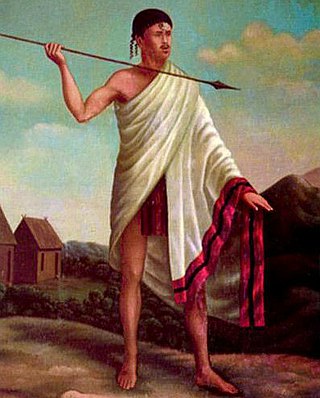
Antananarivo, also known by its colonial shorthand form Tana, is the capital and largest city of Madagascar. The administrative area of the city, known as Antananarivo-Renivohitra, is the capital of Analamanga region. The city sits at 1,280 m (4,199 ft) above sea level in the center of the island, the highest national capital by elevation among the island countries. It has been the country's largest population center since at least the 18th century. The presidency, National Assembly, Senate and Supreme Court are located there, as are 21 diplomatic missions and the headquarters of many national and international businesses and NGOs. It has more universities, nightclubs, art venues, and medical services than any city on the island. Several national and local sports teams, including the championship-winning national rugby team, the Makis are based here.

Andrianampoinimerina (1745–1810) ruled the Kingdom of Imerina on Madagascar from 1787 until his death. His reign was marked by the reunification of Imerina following 77 years of civil war, and the subsequent expansion of his kingdom into neighboring territories, thereby initiating the unification of Madagascar under Merina rule. Andrianampoinimerina is a cultural hero and holds near mythic status among the Merina people, and is considered one of the greatest military and political leaders in the history of Madagascar.

Ambohimanga is a hill and traditional fortified royal settlement (rova) in Madagascar, located approximately 24 kilometers (15 mi) northeast of the capital city of Antananarivo. It is situated in the commune of Ambohimanga Rova.

The Rova of Antananarivo is a royal palace complex (rova) in Madagascar that served as the home of the sovereigns of the Kingdom of Imerina in the 17th and 18th centuries, as well as of the rulers of the Kingdom of Madagascar in the 19th century. Its counterpart is the nearby fortified village of Ambohimanga, which served as the spiritual seat of the kingdom in contrast to the political significance of the Rova in the capital. Located in the central highland city of Antananarivo, the Rova occupies the highest point on Analamanga, formerly the highest of Antananarivo's many hills. Merina king Andrianjaka, who ruled Imerina from around 1610 until 1630, is believed to have captured Analamanga from a Vazimba king around 1610 or 1625 and erected the site's first fortified royal structure. Successive Merina kings continued to rule from the site until the fall of the monarchy in 1896, frequently restoring, modifying or adding royal structures within the compound to suit their needs.

Andriana was both the noble class and a title of nobility in Madagascar. Historically, many Malagasy ethnic groups lived in highly stratified caste-based social orders in which the andriana were the highest strata. They were above the Hova and Andevo (slaves). The Andriana and the Hova were a part of Fotsy, while the Andevo were Mainty in local terminology.

The Merina Kingdom, or Kingdom of Madagascar, officially the Kingdom of Imerina, was a pre-colonial state off the coast of Southeast Africa that, by the 18th century, dominated most of what is now Madagascar. It spread outward from Imerina, the Central Highlands region primarily inhabited by the Merina ethnic group with a spiritual capital at Ambohimanga and a political capital 24 km (15 mi) west at Antananarivo, currently the seat of government for the modern state of Madagascar. The Merina kings and queens who ruled over greater Madagascar in the 19th century were the descendants of a long line of hereditary Merina royalty originating with Andriamanelo, who is traditionally credited with founding Imerina in 1540.
Andrianjaka reigned over the Kingdom of Imerina in the central highlands region of Madagascar from around 1612 to 1630. Despite being the younger of King Ralambo's two sons, Andrianjaka succeeded to the throne on the basis of his strength of character and skill as a military tactician. The most celebrated accomplishment of his reign was the capture of the hill of Analamanga from a Vazimba king. There he established the fortified compound (rova) that would form the heart of his new capital city of Antananarivo. Upon his orders, the first structures within this fortified compound were constructed: several traditional royal houses were built, and plans for a series of royal tombs were designed. These buildings took on an enduring political and spiritual significance, ensuring their preservation until being destroyed by fire in 1995. Andrianjaka obtained a sizable cache of firearms and gunpowder, materials that helped to establish and preserve his dominance and expand his rule over greater Imerina.
The following is a timeline of the history of the city of Tunis, Tunisia.
The following is a timeline of the history of the city of Lomé, Togo.
The following is a timeline of the history of the city of Conakry, Guinea.
The following is a timeline of the history of the city of Marrakesh, Morocco.
The following is a timeline of the history of the city of Oran, Algeria.
The following is a timeline of the history of Djibouti, Djibouti.
The following is a timeline of the history of the city of Niamey, Niger.
The following is a timeline of the history of the city of Ouagadougou, Burkina Faso.
The following is a timeline of the history of the city of Libreville, Gabon.
The following is a timeline of the history of the city of Bangui, Central African Republic.
The following is a timeline of the history of the city of Yaoundé, Cameroon.
The following is a timeline of the history of the city of Nouakchott, Mauritania.
The following is a timeline of the history of the city of Saint-Louis, Senegal.







